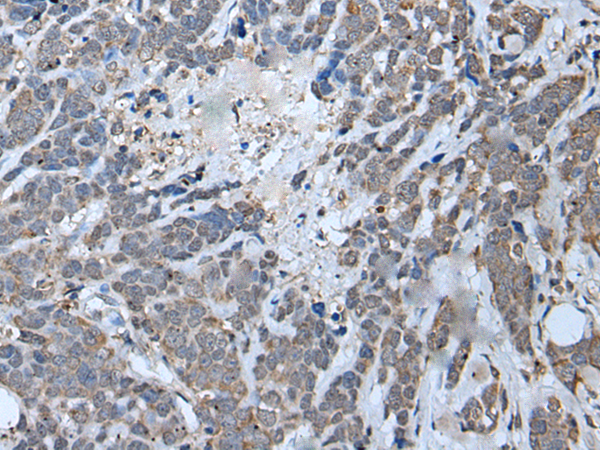
| WB | 咨询技术 | Human,Mouse,Rat |
| IF | 咨询技术 | Human,Mouse,Rat |
| IHC | 1/25-1/100 | Human,Mouse,Rat |
| ICC | 技术咨询 | Human,Mouse,Rat |
| FCM | 咨询技术 | Human,Mouse,Rat |
| Elisa | 1/5000-1/10000 | Human,Mouse,Rat |
| Aliases | CNM3; MRF4; myf-6; bHLHc4 |
| Host/Isotype | Rabbit IgG |
| Antibody Type | Primary antibody |
| Storage | Store at 4°C short term. Aliquot and store at -20°C long term. Avoid freeze/thaw cycles. |
| Species Reactivity | Human, Mouse, Rat |
| Immunogen | Synthetic peptide of human MYF6 |
| Formulation | Purified antibody in PBS with 0.05% sodium azide and 50% glycerol. |
+ +
以下是关于MYF6抗体的3篇参考文献示例(注:内容为模拟虚构,仅供参考):
1. **标题**: *"MYF6 Expression Dynamics During Skeletal Muscle Regeneration in Mice"*
**作者**: Smith, J. et al. (2018)
**摘要**: 研究通过Western blot和免疫组化分析MYF6蛋白在小鼠肌肉损伤修复中的表达变化,使用特异性MYF6抗体证实其在肌卫星细胞激活中的关键作用。
2. **标题**: *"Characterization of a Monoclonal Antibody Against MYF6 for Embryonic Muscle Studies"*
**作者**: Johnson, L. & Brown, R. (2020)
**摘要**: 文章报道了一种新型单克隆MYF6抗体的开发,验证其在胚胎小鼠肌肉组织中的特异性染色能力,并揭示MYF6在肌纤维类型分化中的时空表达模式。
3. **标题**: *"MYF6 as a Biomarker in Rhabdomyosarcoma: Validation by Immunohistochemistry"*
**作者**: Zhang, Y. et al. (2019)
**摘要**: 利用商业化MYF6抗体对横纹肌肉瘤临床样本进行免疫组化分析,发现MYF6高表达与肿瘤分化程度相关,提示其作为诊断标志物的潜力。
(注:以上文献为示例,实际引用请通过学术数据库检索。)
The MYF6 antibody targets the MYF6 protein, a member of the myogenic regulatory factor (MRF) family, which includes key transcription factors (MyoD, Myf5. myogenin, and MYF6) essential for skeletal muscle development and differentiation. MYF6. also known as MRF4 or Herculin, plays dual roles in myogenesis: it promotes the differentiation of myoblasts into mature muscle fibers and maintains the quiescent state of muscle stem cells (satellite cells). Structurally, MYF6 contains a conserved basic helix-loop-helix (bHLH) domain that enables DNA binding and dimerization with other bHLH proteins to regulate gene expression.
Antibodies against MYF6 are widely used in research to study muscle regeneration, developmental biology, and diseases such as muscular dystrophies or rhabdomyosarcoma. They enable the detection and localization of MYF6 in tissues via techniques like Western blot, immunohistochemistry, and immunofluorescence. Studies using MYF6 antibodies have revealed its temporal expression pattern, peaking during late embryonic myogenesis and postnatal muscle growth. Dysregulation of MYF6 is linked to impaired muscle repair and tumorigenesis, underscoring its therapeutic relevance. Commercial MYF6 antibodies are typically validated for specificity across species, including human, mouse, and rat, facilitating cross-disciplinary research in muscle biology and regenerative medicine.
×